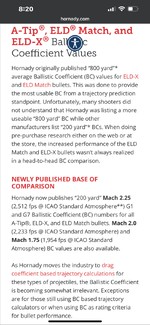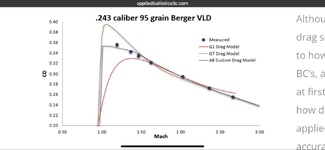wind gypsy
WKR
- Joined
- Dec 30, 2014
- Messages
- 8,382
There's a fair bit of discrepancy between AB's listed BCs and Hornady's for the ELDm line and it's not just a consistent % difference. For example, I always assumed the 75 ELDm had a better form factor than the 80 because the Hornady listed BC is very close. AB's #'s say the opposite.
Based on AB #s, the 80 ELDm looks really good for a balance of possible velocity and BC while Hornady's #'s make the 75 and 88 more attractive. When the 3 bullets are placed next to each other, the eye test indicates the BCs should align more with Hornady's BC progression - the 80 looks like just bearing surface added to a 75 at best, maybe even a shorter nose. The 88 looks like nose and boattail length added to an 80.
I'm curious on other's thoughts. Is this possibly just lot to lot variance on bullets that were tested?
There's a similar thing going on with the .257 134 grain and .264 140 grain - Hornady lists them at basically the same BC which to me suggests there would be very little benefit to the .25 creed vs 6.5 creed with these two bullets as the velocity benefit of the 134 should be small. However, AB #'s significantly favor the 134 so having a velocity, BC, and recoil advantage would give it the bigger edge.
I use AB custom curves for solutions rather than BC #s and realize this is mostly just noise in any of my real life applications but I found it interesting for discussion.
| Hornady G7 | AB G7 | |
75 | 0.235 | 0.238 |
80 | 0.244 | 0.258 |
88 | 0.274 | 0.264 |
Based on AB #s, the 80 ELDm looks really good for a balance of possible velocity and BC while Hornady's #'s make the 75 and 88 more attractive. When the 3 bullets are placed next to each other, the eye test indicates the BCs should align more with Hornady's BC progression - the 80 looks like just bearing surface added to a 75 at best, maybe even a shorter nose. The 88 looks like nose and boattail length added to an 80.
I'm curious on other's thoughts. Is this possibly just lot to lot variance on bullets that were tested?
There's a similar thing going on with the .257 134 grain and .264 140 grain - Hornady lists them at basically the same BC which to me suggests there would be very little benefit to the .25 creed vs 6.5 creed with these two bullets as the velocity benefit of the 134 should be small. However, AB #'s significantly favor the 134 so having a velocity, BC, and recoil advantage would give it the bigger edge.
I use AB custom curves for solutions rather than BC #s and realize this is mostly just noise in any of my real life applications but I found it interesting for discussion.
Last edited:





